How Well Does the QNAP TS-464 NAS Perform as a Plex Media Server?
When it comes to buying your first NAS drive, very few NAS brands provide the level of hardware vs value that QNAP does. The new TS-464 is the latest release by the brand to produce a mid-range/prosumer NAS solution that can do a little bit of everything – and many users are wondering how well it can run Plex Media Server. Arriving with an embedded graphics enabled Intel Quad Core CPU, plenty of memory and numerous options for scalability, the TS-464 is going to be a solid system for 1080p and 4K multimedia natively, but then Plex is very different to typical/bog-standard media playback – stylizing itself much more than most. The appeal of accessing all the movies, boxsets, music and home movies that you physically/digitally own in the style popularized by Netflix, Disney+ and Prime Video (flashy GUI, summary, all the box art, trailers, cast details, reviews and more) is undeniable. The rise in popularity of streaming platforms like Netflix has also been accompanied by rising monthly subscription costs and rising concerns about never truly owning the media that you want o watch. Even when you buy movies and TV boxsets in digital download forms from Amazon Video etc, you are still at the mercy of 1) needing somewhere to store it if you do choose to download it and 2) potentially losing access to it if the site/platform you purchased from has lost the license to host it (a common complain of the increasingly digital world of PC/Console gaming, as games are pulled from eStores). Hosting your media in a subscription-free form, whilst it still being presented in the universally accessible and premium GUI form of Plex is one of the most compelling reasons for many home/prosumer users deciding to make the jump towards buying their own plex media server. However, NAS drives have grown incredibly diverse in terms of hardware design and therefore one NAS might not play media in plex as well/efficiently as another – and the QNAP TS-464 NAS is no exception to this. Today I want to detail my tests of the TS-464 as a Plex Media Server and I hope this will help you decide whether a QNAP NAS deserves your Multimedia in 2022/2023.
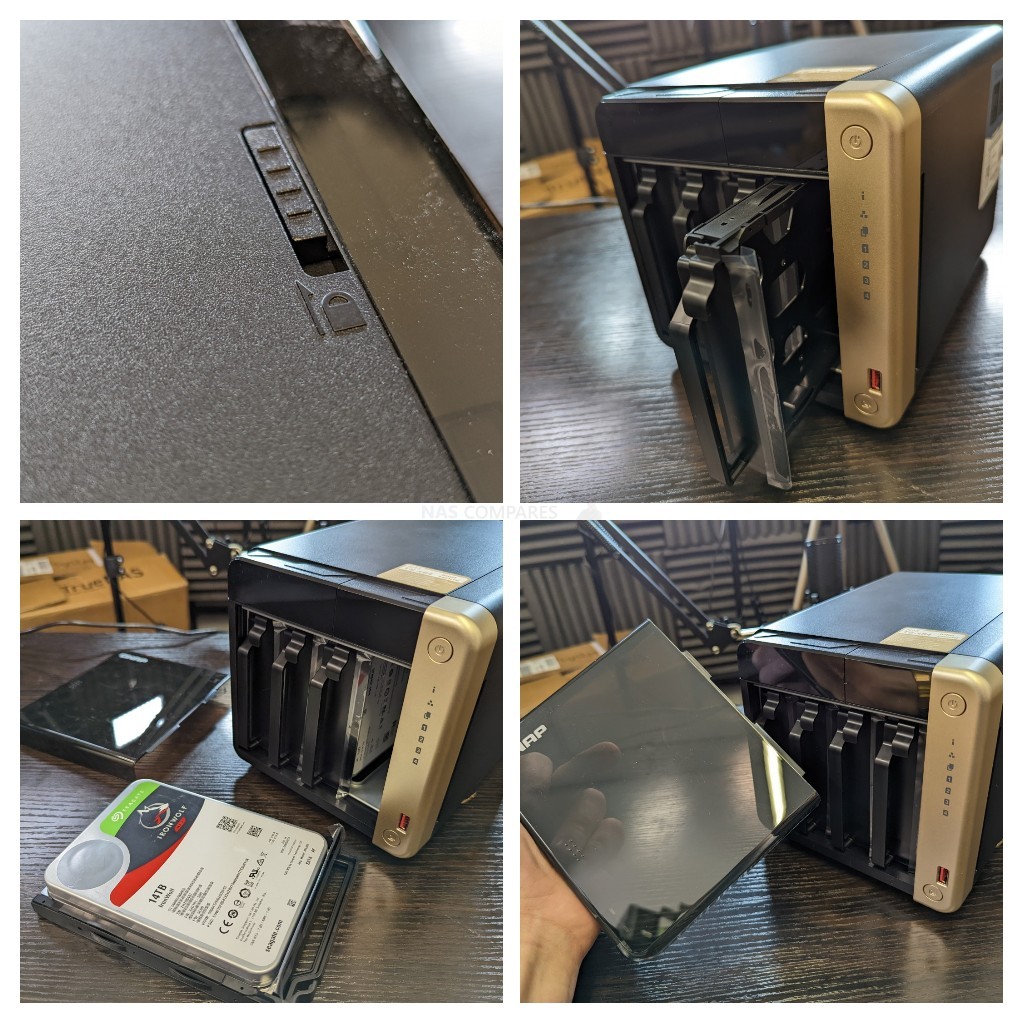
What is the Hardware of the QNAP TS-464 NAS Drive?

The QNAP TS-464 NAS drive is quite similar in architecture to most PCs or Laptops (in that it features a CPU+Memory+Storage), but differs in that it’s components are designed to be more efficient (as they will be in operation 24×7) and have a larger degree of focus on storage-related applications (where as the hardware in a PC/Laptop is designed more for the applications you run with storage service concerns/provisions being far more rudimentary). The TS-464 is made up of a popular mid-range server CPU, DDR4 memory and supports Hard Drive and SSDs in SATA. although most of the specifications of QNAP NAS drives are unrelated to Plex, below I have picked up the hardware specifications of the TS-464 that are relevant to Plex:
- CPU: Intel N5105 Celeron, 4-Core / 4-Thread, 2.0-2.9Ghz
- Embedded Graphics: Yes
- Memory (Quantity & Maximum): 4-16GB DDR4 SODIMM (upto 3200Mhz)
- Number of Storage Bays: 4x SATA Bays
- M.2 NVMe Caching Bays: 2x NVMe M.2, PCIe 3 x1
- Network Connectivity: 2x 2.5GbE + Optional PCIe Upgrade Slot for 10GbE
Next, let’s quickly touch on how we measure how good/bad the QNAP TS-464 NAS is for Plex Media Server.
Understanding the Plex Media Server Tests of the QNAP TS-464 NAS
![]()
Important Terms to Understand in Plex/NAS/Multimedia that will make the TS-464 NAS Plex Tests Easier to Understand.
- SD, 160p, 240p, 480p, 720p, 1080p, 4K : This is the resolution that the media is being displayed at. The higher the resolution, the larger number of pixels that are available and depending on the original recording quality of the media in question. High resolutions, such as 1080p and 4K require more work to be done by the NAS hardware in order to playback the file. More often than not, a NAS with weak embedded graphics or no embedded graphics at all will be unable to play 4K very well or indeed at all. It is important to remember that just because a NAS brand like QNAP says that their latest NAS can natively play back 1080p or 4K media (natively = played using their own NAS software, software client tools and/or DLNA), that does not mean that the TS-464 will play to the same standard in Plex, as Plex is a 3rd party tool
- Transcoding, Encoding, Decoding : These are all different techniques/names for when a file needs to be changed in order to be better suited to the connected client device connection, strength or hardware. If you are accessing all your media on the local area network (i.e only accessing your plex media at home), then transcoding will rarely be something you will use (unless your media is largely H.265/HEVC based, see earlier). However, perhaps you are accessing your plex library on the train to work or from a sun bed whilst on holiday. Perhaps you have a smaller data bandwidth/allowed MB/GB, maybe a weaker internet connection, perhaps you are using a smaller phone device and you might not need to watch your 4K 50GB Blu-ray rip of the latest Marvel Movie – in these situations, you might well want to access the media on your QNAP TS-464 Plex NAS at a lesser quality than the original version, so transcoding/re-encoding on the fly (as in, at the same time it is being played) is what you would want to do. Remember, transcoding is by far the most heavy-weight thing you will need to do on a NAS. It is also worth remembering that in order for Plex o be able to use the FULL resources of a NAS CPU (such as embedded graphics) that you will need to enable ‘Make My CPU Hurt’ in the Encoder Menu of the Plex NAS Settings menu – this also potentially requires a Plex Pass subscription, depending on the NAS in question
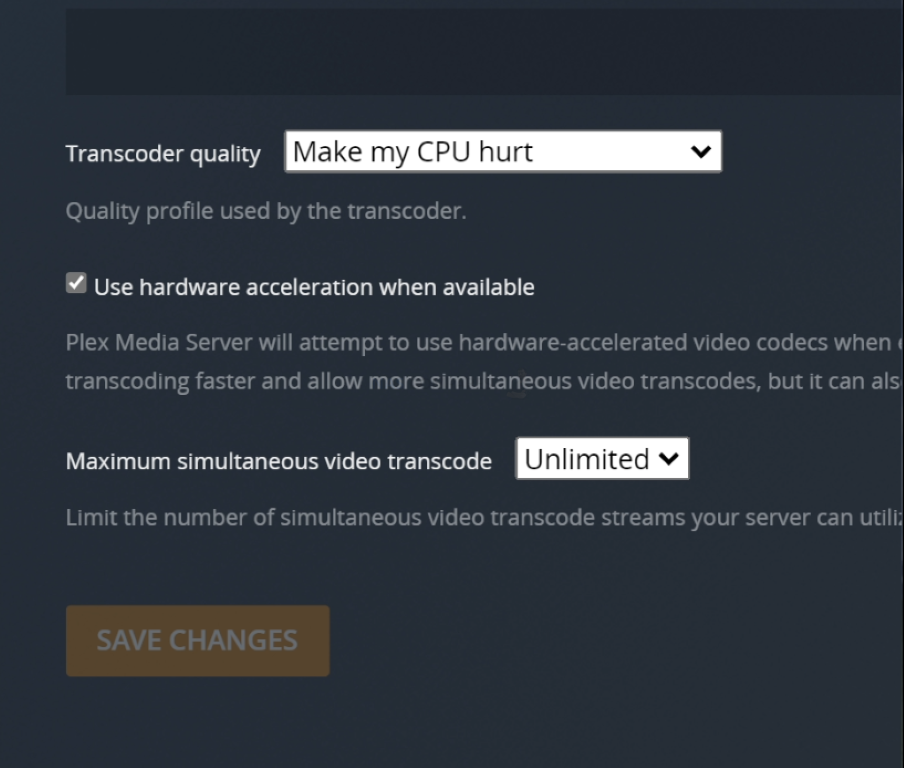
- H.264, HEVC, H.265 : These are compression techniques that are designed to allow large-scale media presentations that were made for a cinema to be viewable from your sofa (with H.265 being the more effective/powerful compression level). H.264 can largely be played by ALL devices, but many devices do not have permission or a license to play H.265/HEVC (they are the same thing). This is because, where H.264 is an easy license and comparatively free to use, H.265/HEVC licencing and patents are spread across multiple providers and allowing a device license to use this compression technique can be complex, expensive or simply impossible. Therefore HEVC/H.265 media will sometimes AUTOMATICALLY need to be converted/transcoded into H.264 etc in order to be played – therefore eating up more system resources. The TS-464, much like the rest of thte QNAP NAS range do not arrive with HEVC support by default
- Bitrate : Bitrate is the amount of data encoded for a unit of time, and for streaming is usually referenced in megabits per second (Mbps) for video, and in kilobits per second (kbps) for audio. Higher quality and higher resolution media tends to be of a much higher bitrate
For more information on the most important terms to understand when discussing/researching a NAS as a Plex Media Server can be found in my video below:
Any further questions, you can use the free advice section at the bottom of the page and ask me and Eddie directly.
How was the QNAP TS-464 NAS Tested in Plex?
The setup for testing the TS-464 NAS for Plex was as follows:
- The QNAP TS-464 NAS was accessed over a 1GbE network, however in order to test how the NAS would cope with transcoding/encoding, I would force the Plex Player client to transcode the file manually
- The TS-464 NAS was used in the default CPU+Memory state that the base model arrives in (no upgraded memory or upgraded caching media)
- Tests were performed one after the other with a short break between each test, so you might see the tail end of the previous test on a CPU graph, but I have pointed at the are of the % utilization that is important as per each test.
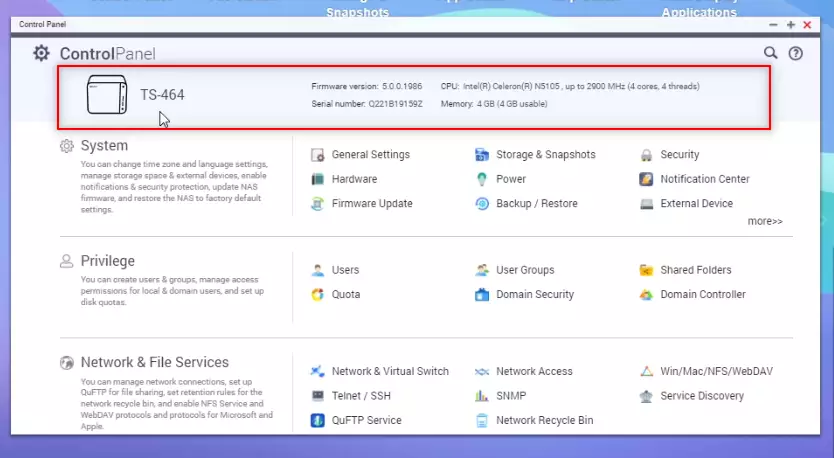
Regarding test results, CLEAR PASS means that the file successfully played and there were sufficient resources for the NAS to continue to do other things comfortably, PLAYED BUT HIGH CPU % means that the file played, but it utilized a significant amount of system resources in order to do so in a heavier use situation (i.e other NAS users connected) it might not play and FAIL AND-OR DID NOT PLAY means that the file either did not play or the time taken to play back the files was outpaced by the natural playback of the file – i.e. the file would stop-and-start constantly in order to try and catch up. If you want to watch the FULL video recording of all the Plex tests that I performed on the QNAP TS-464 NAS, you can watch the video below. Be warned, it is quite long! Alternatively, you can scroll past and see each of the test results, one-by-one, detailing which ones worked and which ones didn’t:
What % System Resources did the QNAP TS-464 NAS Use in Plex when Idle?
Running the Plex Media Server application, even when no multimedia is being played on the TS-464 is still going to require a % of system resources to be occupied, in order to ensure that PLEX can play media from the QNAP NAS as soon as it is requested remotely. Additionally, although Plex runs at its best with at least 2 Cores of CPU power and 2GB of Memory, many NAS also reserve areas of CPU/RAM for the system itself. So, therefore, knowing how much system resources are being consumed by the QNAP TS-464 NAS when Plex is idle is going to be useful to know how much system power is available when playback actually starts. Here is a screenshot of the TS-464 when Plex is running, but no media is being played/accessed:
Plex Test 1 – QNAP TS-464 Plex NAS – Matrix 720p 0.7Mbps h.264 Original Playback
Here is how the QNAP TS-464 Plex NAS – Matrix 720p 0.7Mbps h.264 Original Playback File Performed:
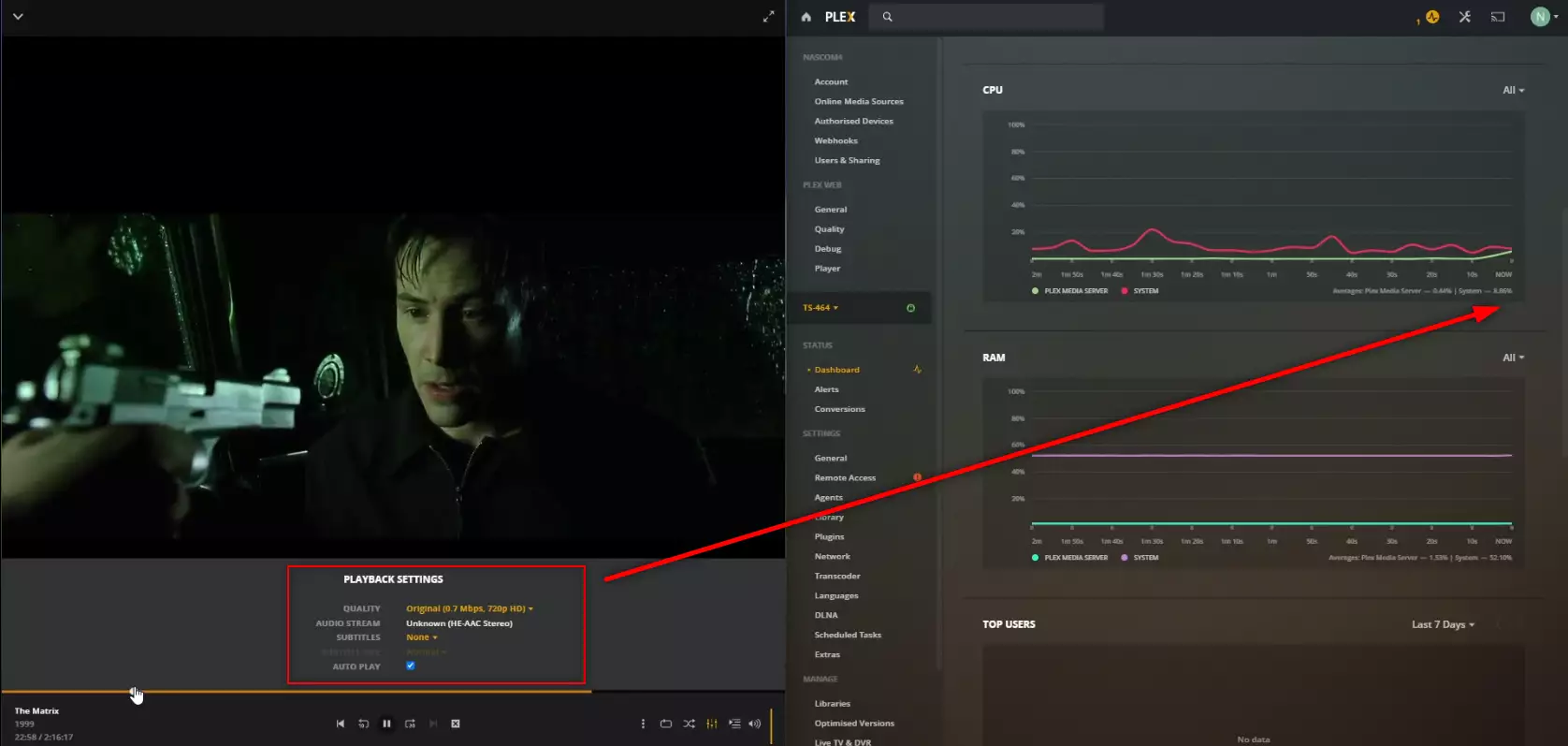
RESULT: CLEAR PASS
Extra Notes: None
Plex Test 2 – QNAP TS-464 Plex NAS – LSOH 1080p 1.9Mbps h.264 Original Playback
Here is how the QNAP TS-464 Plex NAS – LSOH 1080p 1.9Mbps h.264 Original Playback File Performed:
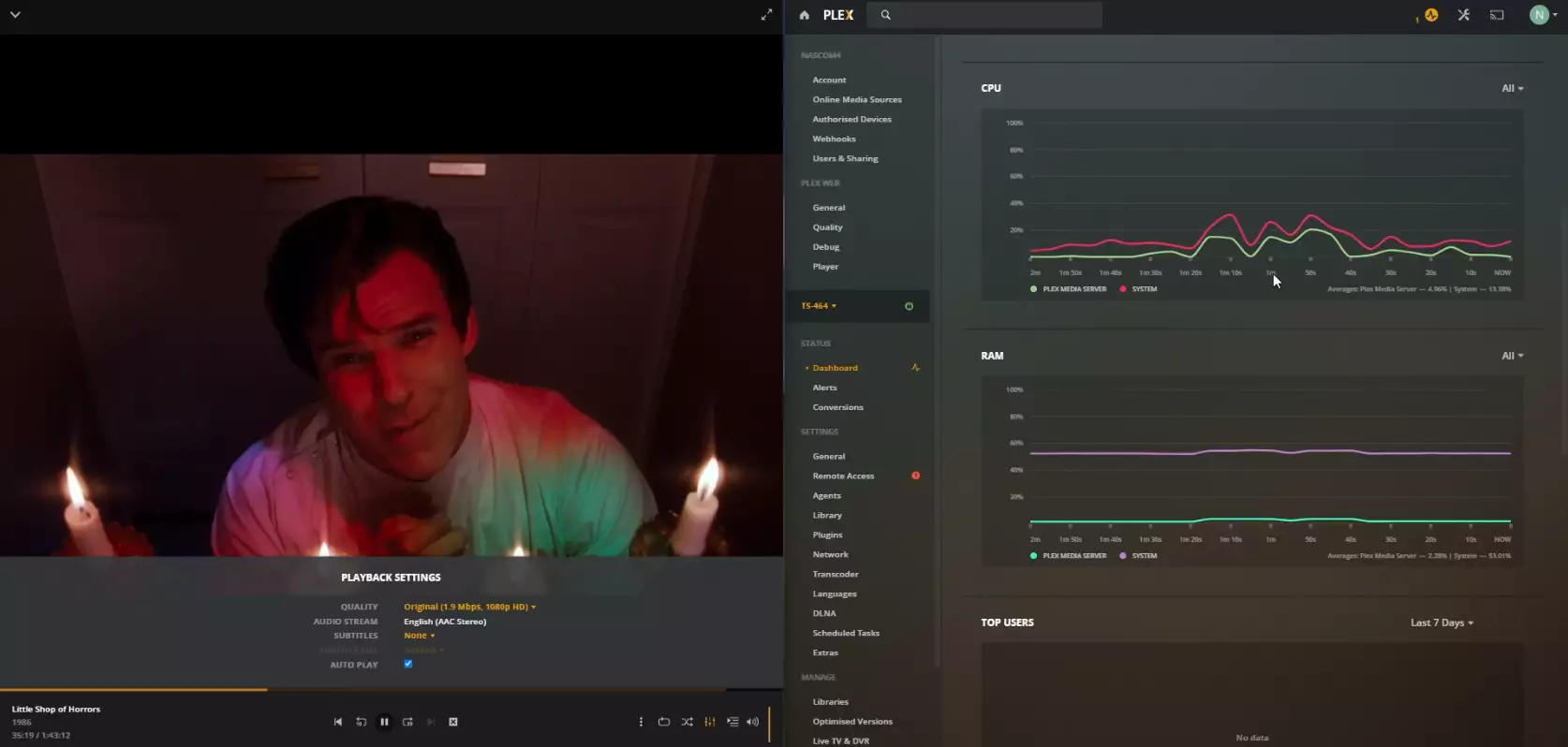
RESULT: CLEAR PASS
Extra Notes: None
Plex Test 3 – QNAP TS-464 Plex NAS – LSOH 1080p 1.9Mbps h.264 Transcode to 720p 2Mbps
Here is how the QNAP TS-464 Plex NAS – LSOH 1080p 1.9Mbps h.264 Transcode to 720p 2Mbps File Performed:
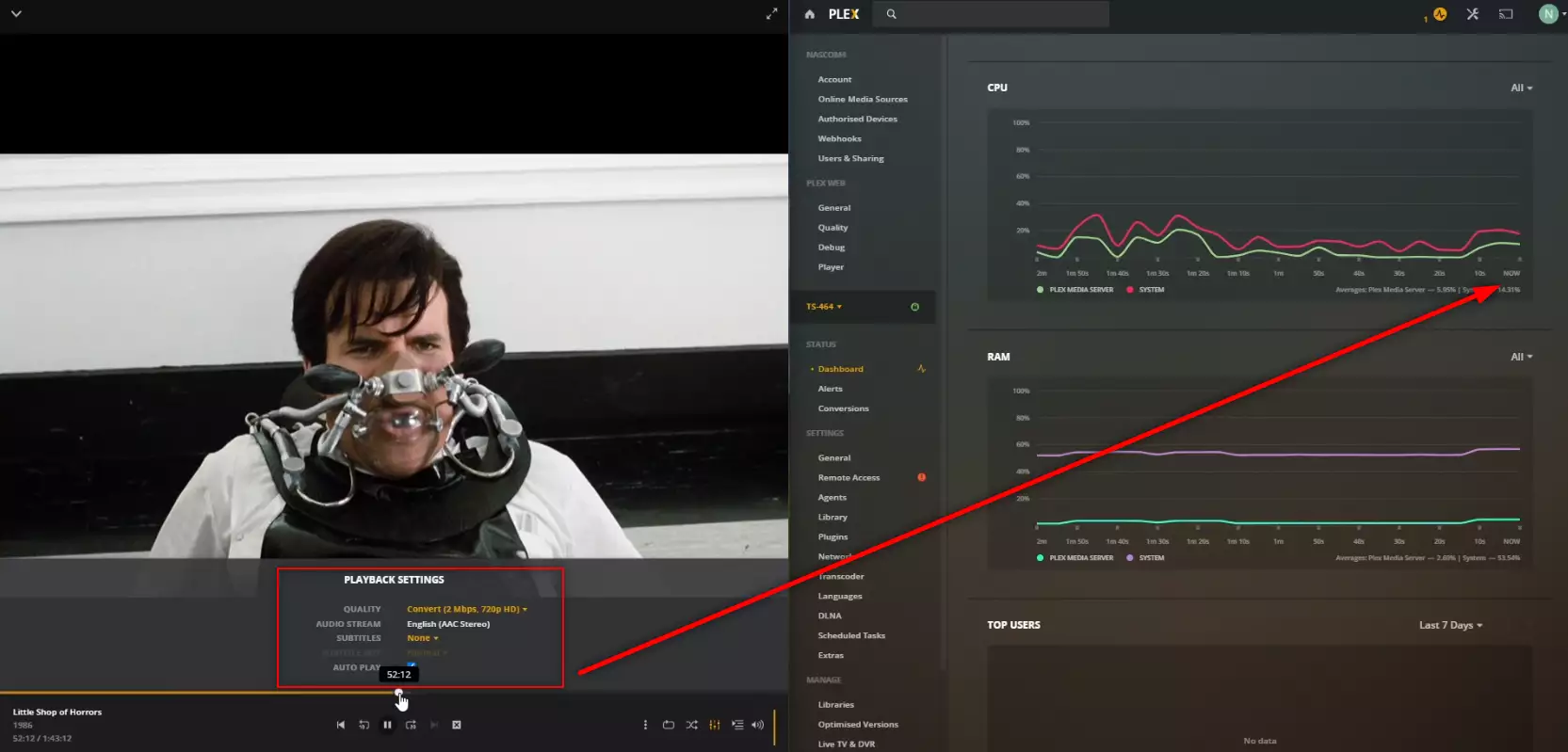
RESULT: CLEAR PASS
Extra Notes: None
Plex Test 4 – QNAP TS-464 Plex NAS – LSOH 1080p 1.9Mbps h.264 Transcode to 480p 1.5Mbps
Here is how the QNAP TS-464 Plex NAS – LSOH 1080p 1.9Mbps h.264 Transcode to 480p 1.5Mbps File Performed:
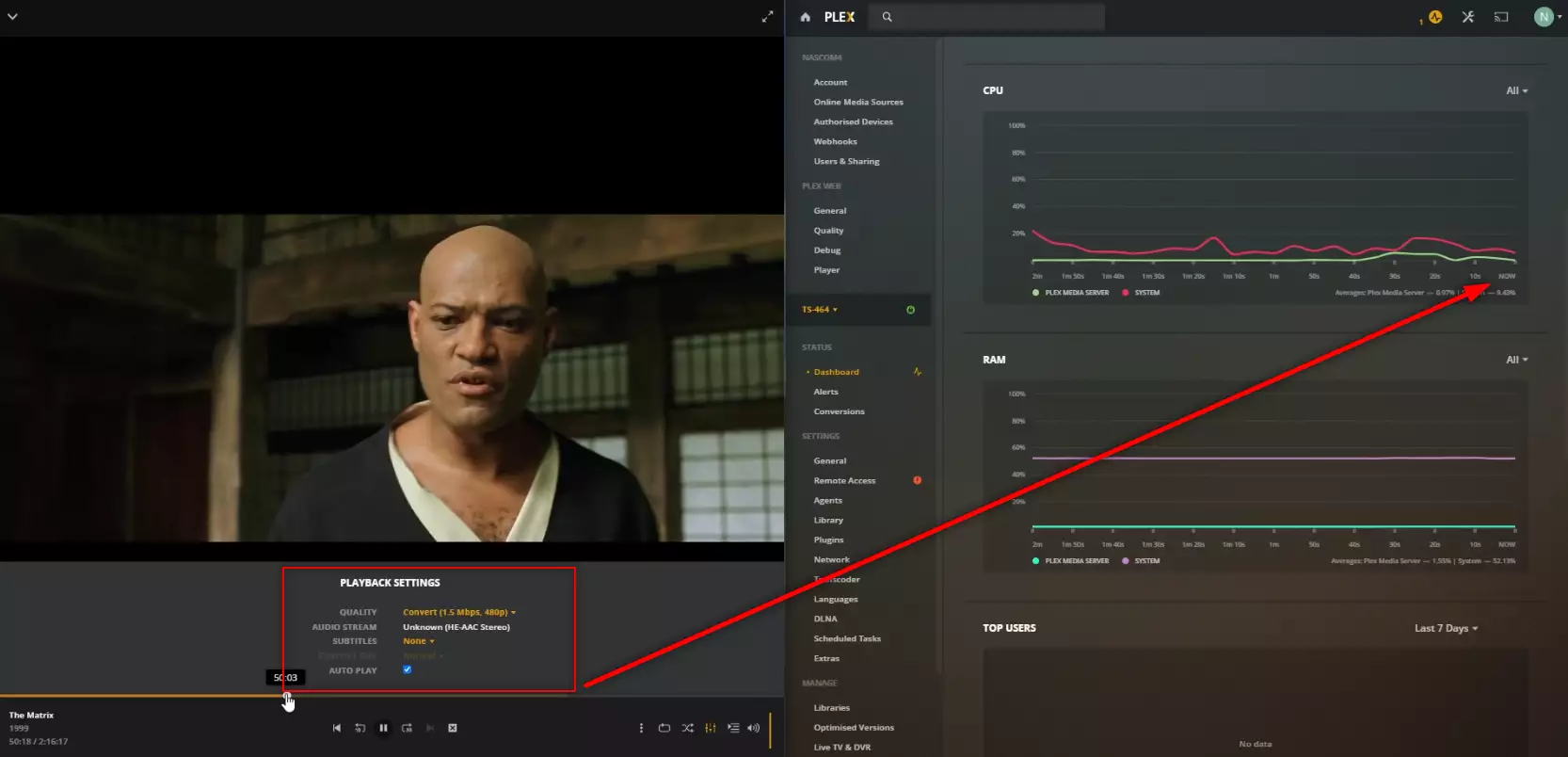
RESULT: CLEAR PASS
Extra Notes: None
Plex Test 5 – QNAP TS-464 Plex NAS – LSOH 1080p 1.9Mbps h.264 Transcode to 160p 0.2Mbps
Here is how the QNAP TS-464 Plex NAS – LSOH 1080p 1.9Mbps h.264 Transcode to 160p 0.2Mbps File Performed:
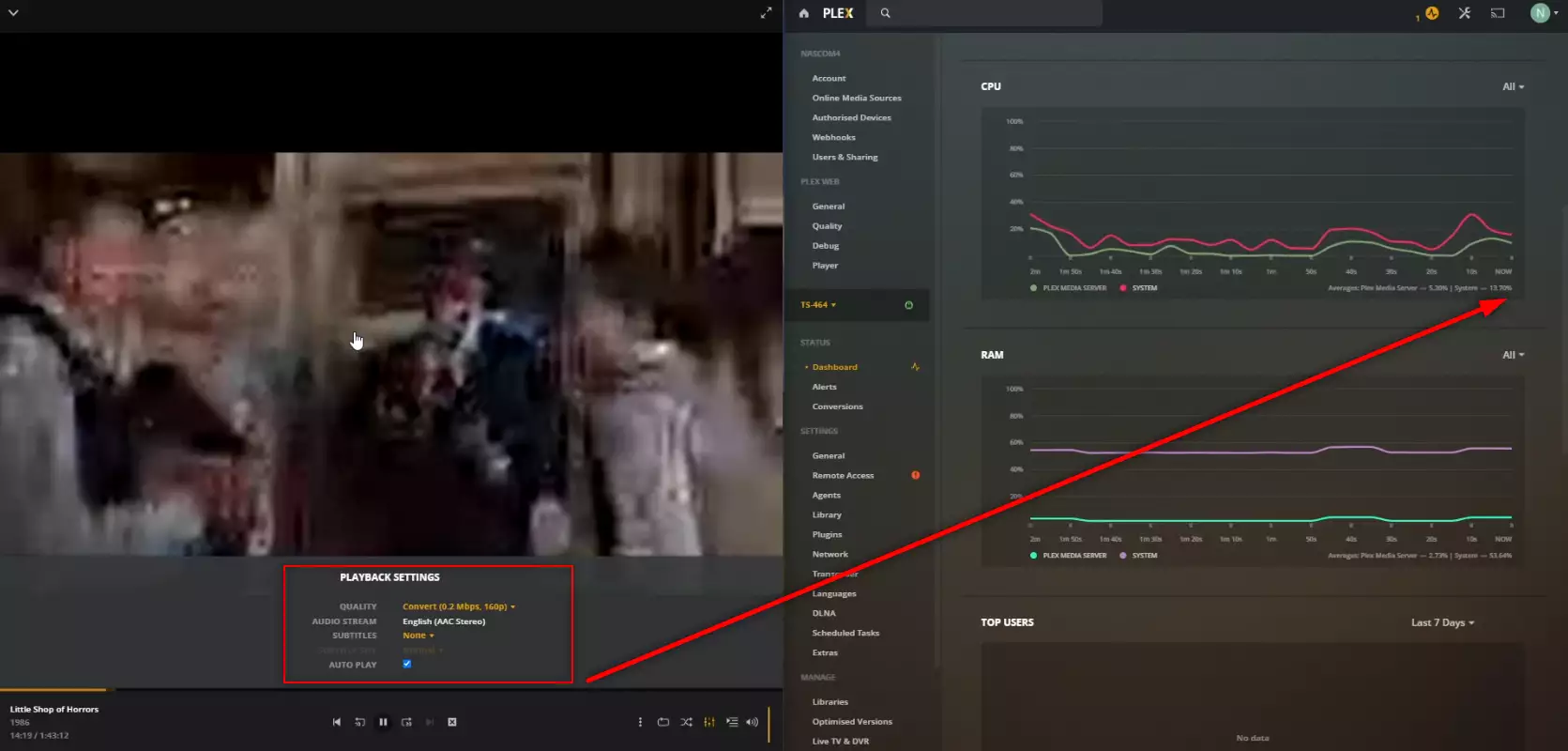
RESULT: CLEAR PASS
Extra Notes: None
Plex Test 6 – QNAP TS-464 Plex NAS – Jellyfish 1080p 3Mbps H.264 Original Playback
Here is how the QNAP TS-464 Plex NAS – Jellyfish 1080p 3Mbps H.264 Original Playback File Performed:

RESULT: CLEAR PASS
Extra Notes: None
Plex Test 7 – QNAP TS-464 Plex NAS – Jellyfish 1080p 3Mbps 10BIT H.265 – HEVC CONVERTED TO H.264
Here is how the QNAP TS-464 Plex NAS – Jellyfish 1080p 3Mbps 10BIT H.265 – HEVC CONVERTED TO H.264 File Performed:
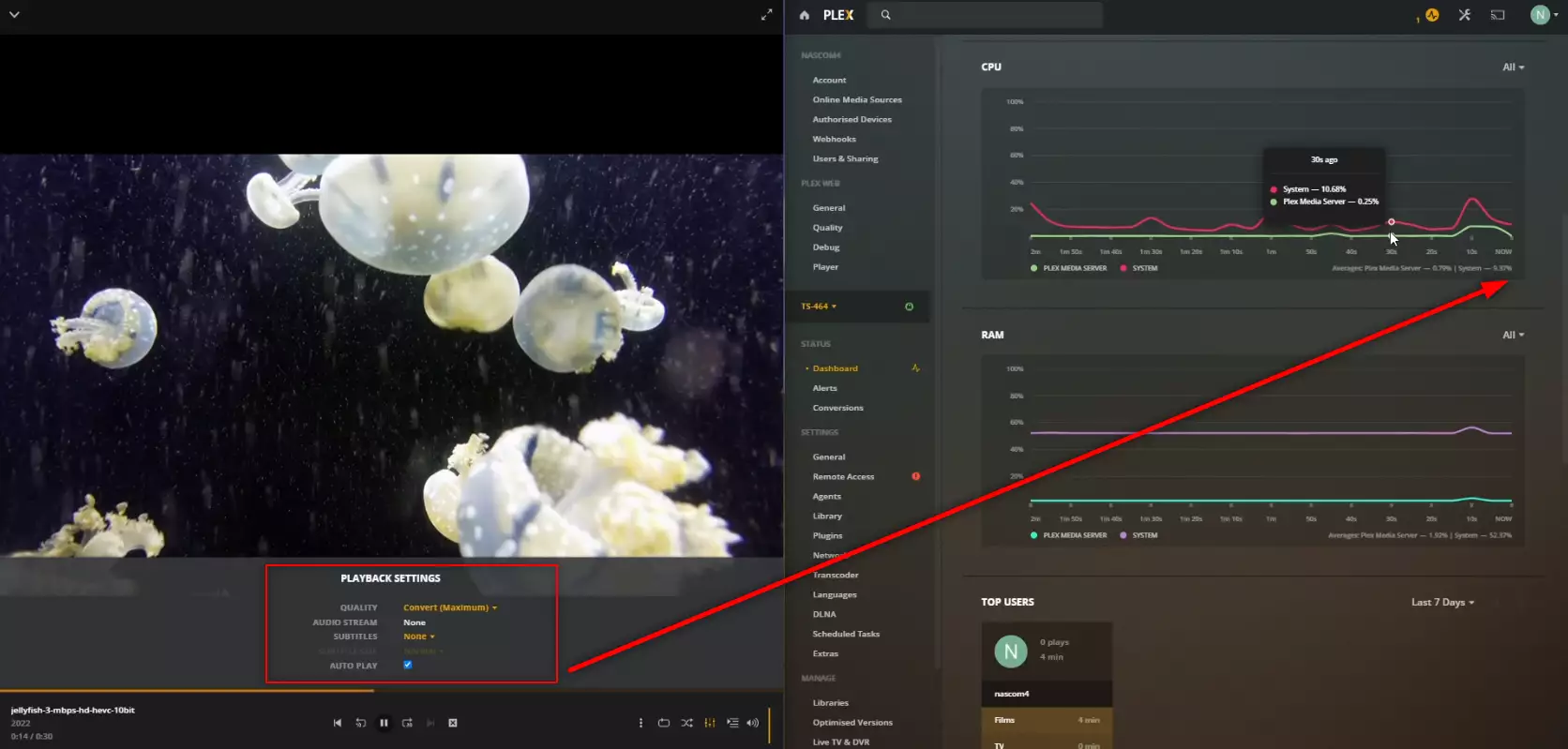
RESULT: CLEAR PASS
Extra Notes: None
Plex Test 8 – QNAP TS-464 Plex NAS – Jellyfish 1080p 10Mbps H.264 Original Playback
Here is how the QNAP TS-464 Plex NAS – Jellyfish 1080p 10Mbps H.264 Original Playback File Performed:
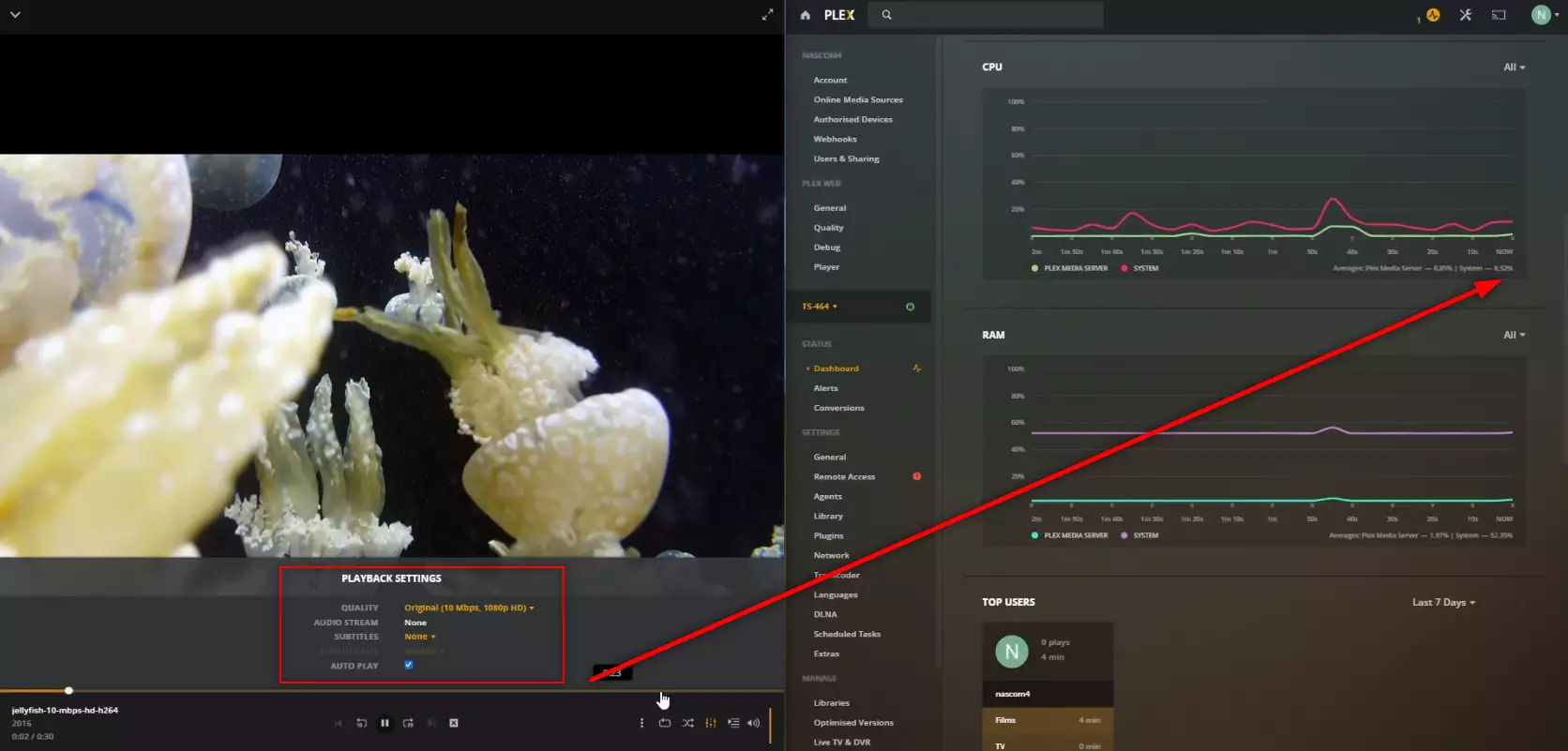
RESULT: CLEAR PASS
Extra Notes: None
Plex Test 9 – QNAP TS-464 Plex NAS – Jellyfish 1080p 30Mbps H.264 Original Playback
Here is how the QNAP TS-464 Plex NAS – Jellyfish 1080p 30Mbps H.264 Original Playback File Performed:
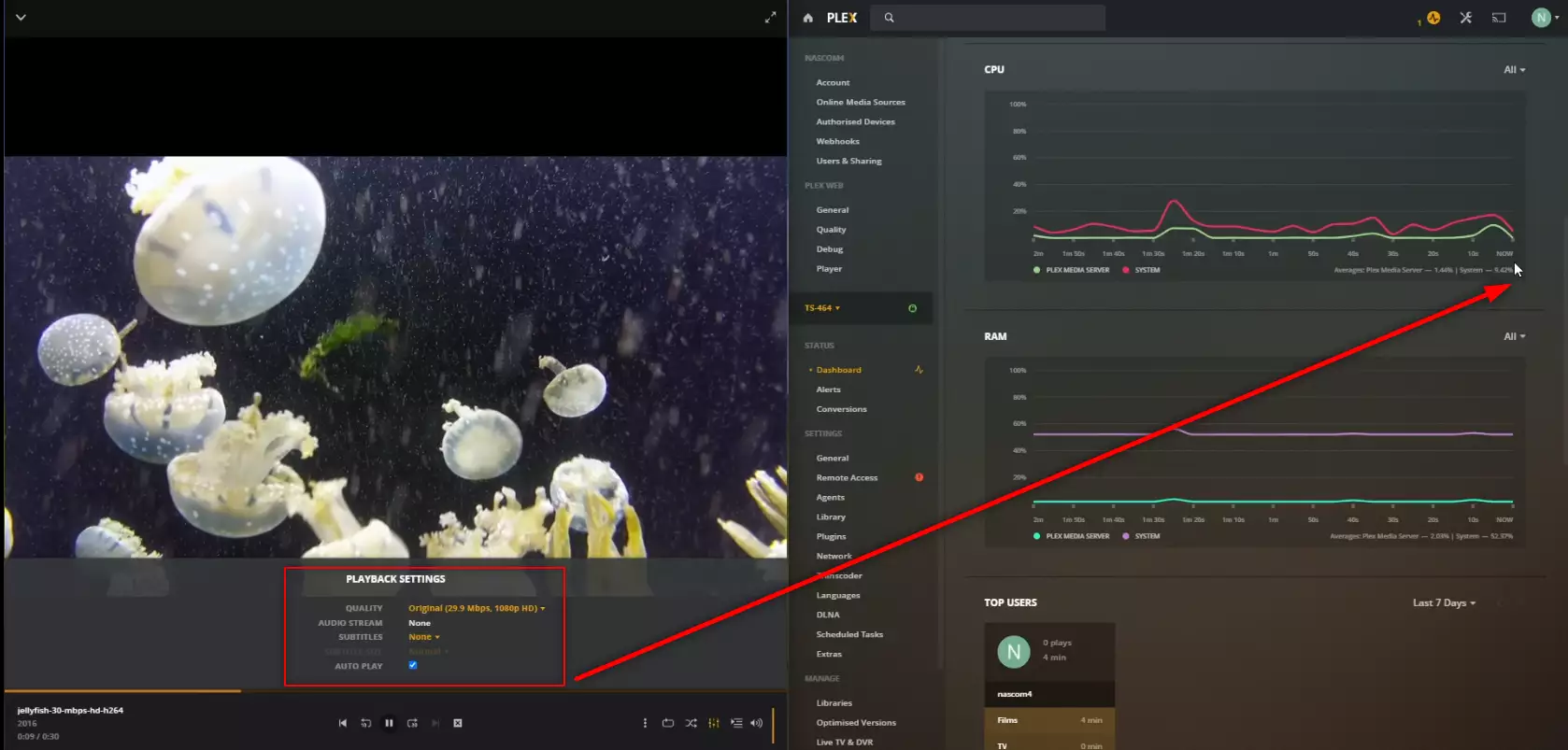
RESULT: CLEAR PASS
Extra Notes: None
Plex Test 10 – QNAP TS-464 Plex NAS – Jellyfish 1080p 10Mbps H.265 – HEVC CONVERTED TO H.264
Here is how the QNAP TS-464 Plex NAS – Jellyfish 1080p 10Mbps H.265 – HEVC CONVERTED TO H.264 File Performed:
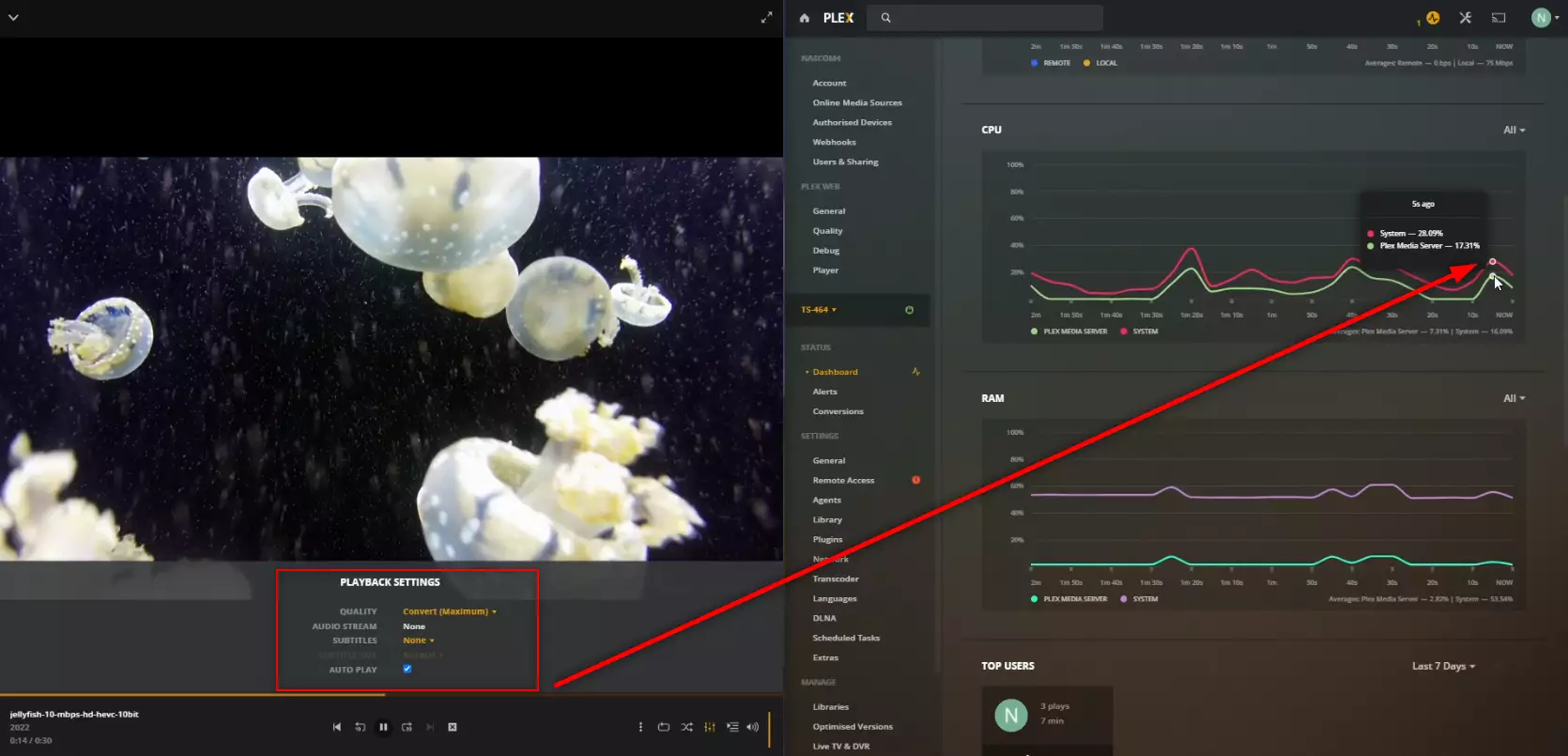
RESULT: CLEAR PASS
Extra Notes: None
Plex Test 11 – QNAP TS-464 Plex NAS – Jellyfish 1080p 100Mbps H.265 – HEVC CONVERTED TO H.264
Here is how the QNAP TS-464 Plex NAS – Jellyfish 1080p 100Mbps H.265 – HEVC CONVERTED TO H.264 File Performed:
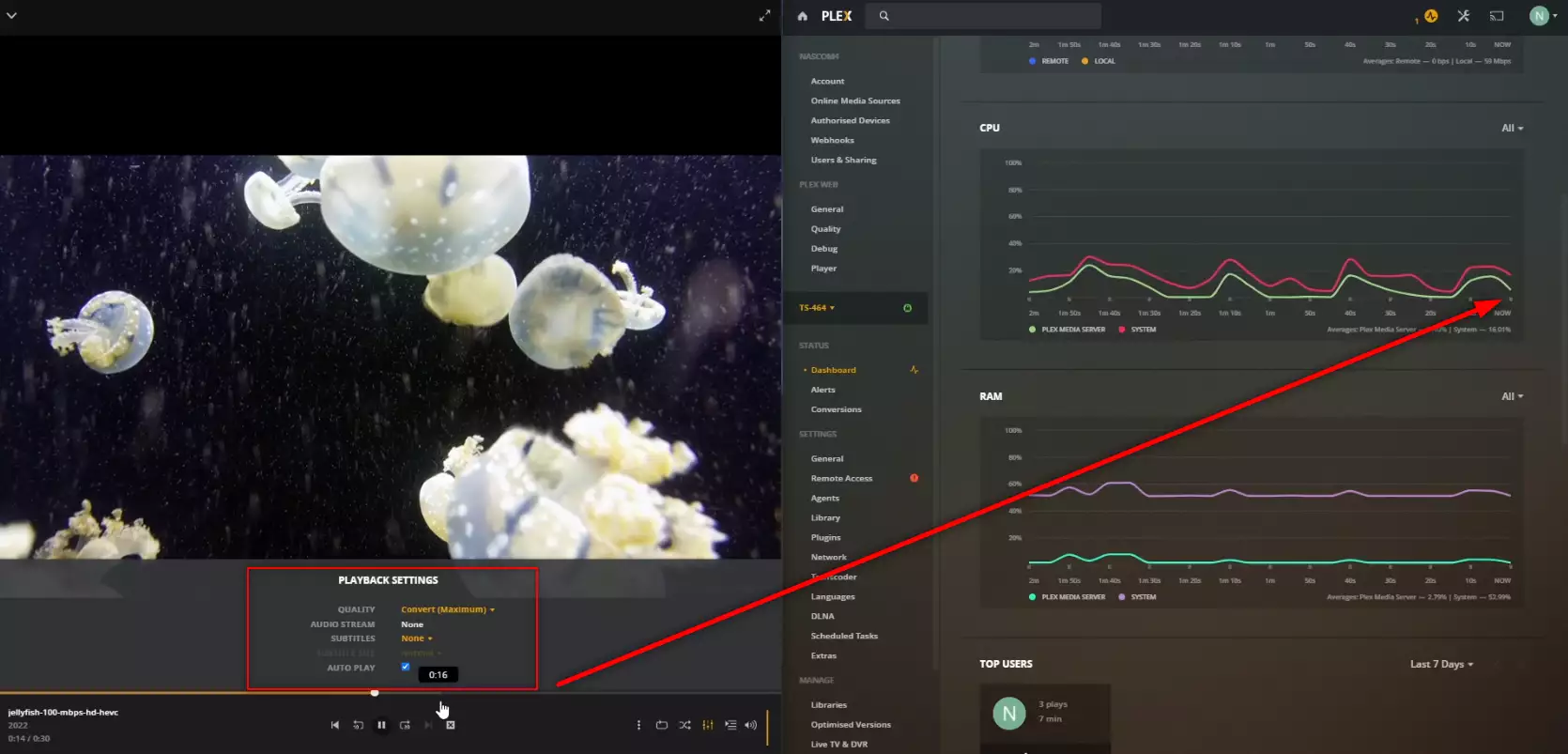
RESULT: CLEAR PASS
Extra Notes: None
Plex Test 12 – QNAP TS-464 Plex NAS – Jellyfish 4K 120Mbps H.264 Original Playback
Here is how the QNAP TS-464 Plex NAS – Jellyfish 4K 120Mbps H.264 Original Playback File Performed:
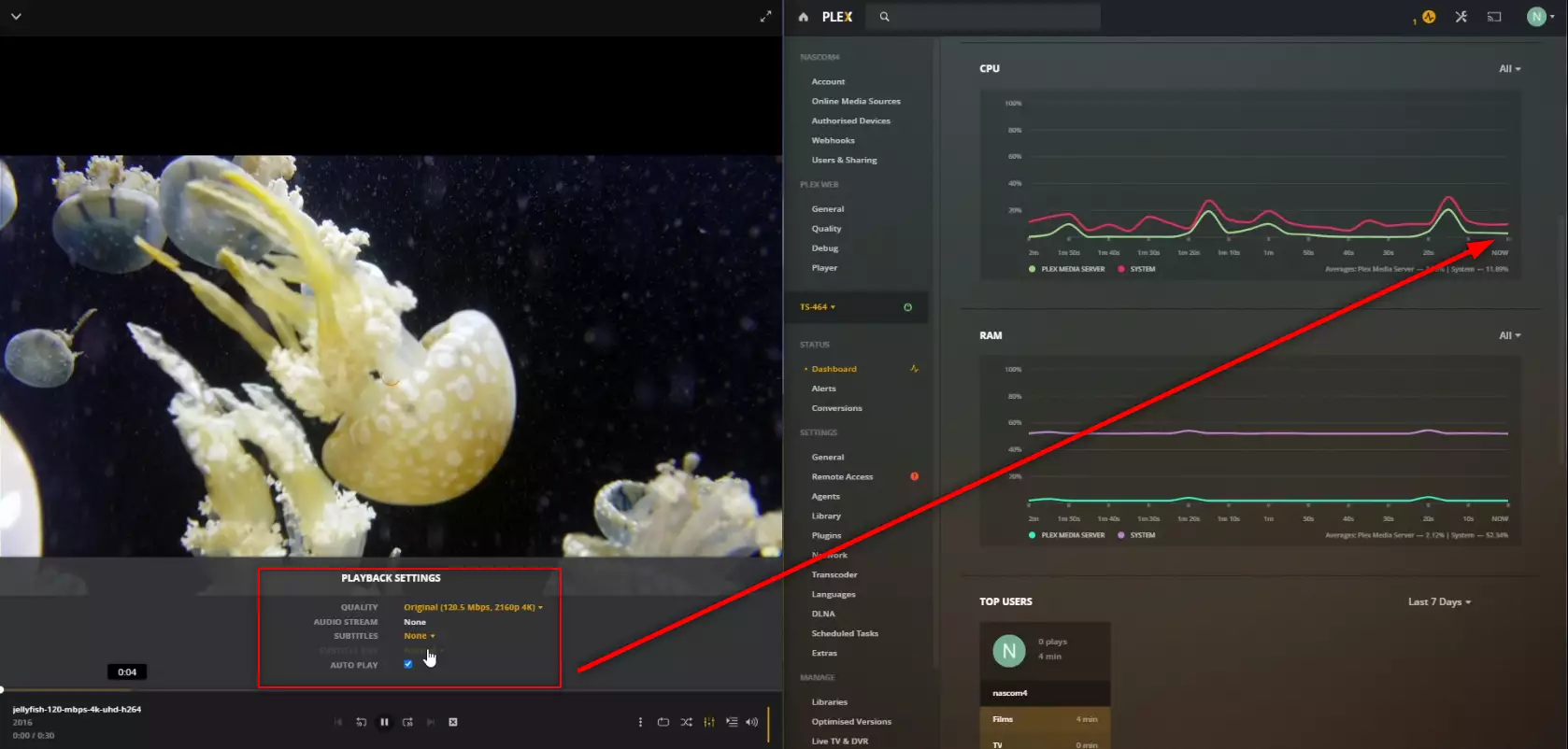
RESULT: FAIL AND-OR DID NOT PLAY
Extra Notes: None
Plex Test 13 – QNAP TS-464 Plex NAS – Jellyfish 4K 120Mbps H.265 – HEVC CONVERTED TO H.264
Here is how the QNAP TS-464 Plex NAS – Jellyfish 4K 120Mbps H.265 – HEVC CONVERTED TO H.264 File Performed:
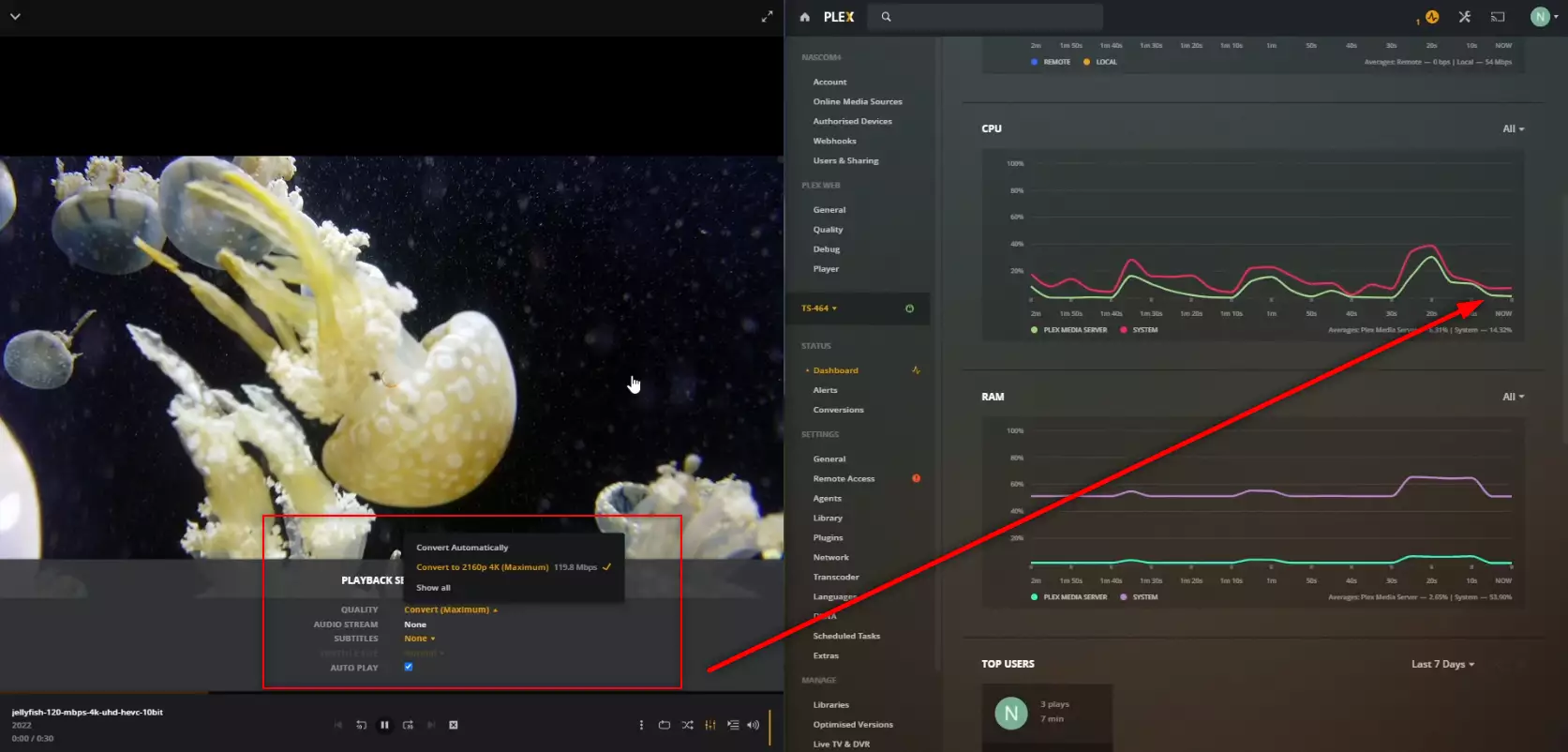
RESULT: FAIL AND-OR DID NOT PLAY
Extra Notes: None
Plex Test 14 – QNAP TS-464 Plex NAS – Jellyfish 4K 120Mbps H.264 Convert to 1080p 100Mbps
Here is how the QNAP TS-464 Plex NAS – Jellyfish 4K 120Mbps H.264 Convert to 1080p 100Mbps File Performed:

RESULT: PLAYED BUT HIGH CPU %
Extra Notes: The file played, however the time difference between playback and how fast the system could transcode on the fly was a little closer than I would like
Plex Test 15 – QNAP TS-464 Plex NAS – Jellyfish 4K 200Mbps H.264 Convert to 1080p 20Mbps
Here is how the QNAP TS-464 Plex NAS – Jellyfish 4K 200Mbps H.264 Convert to 1080p 20Mbps File Performed:
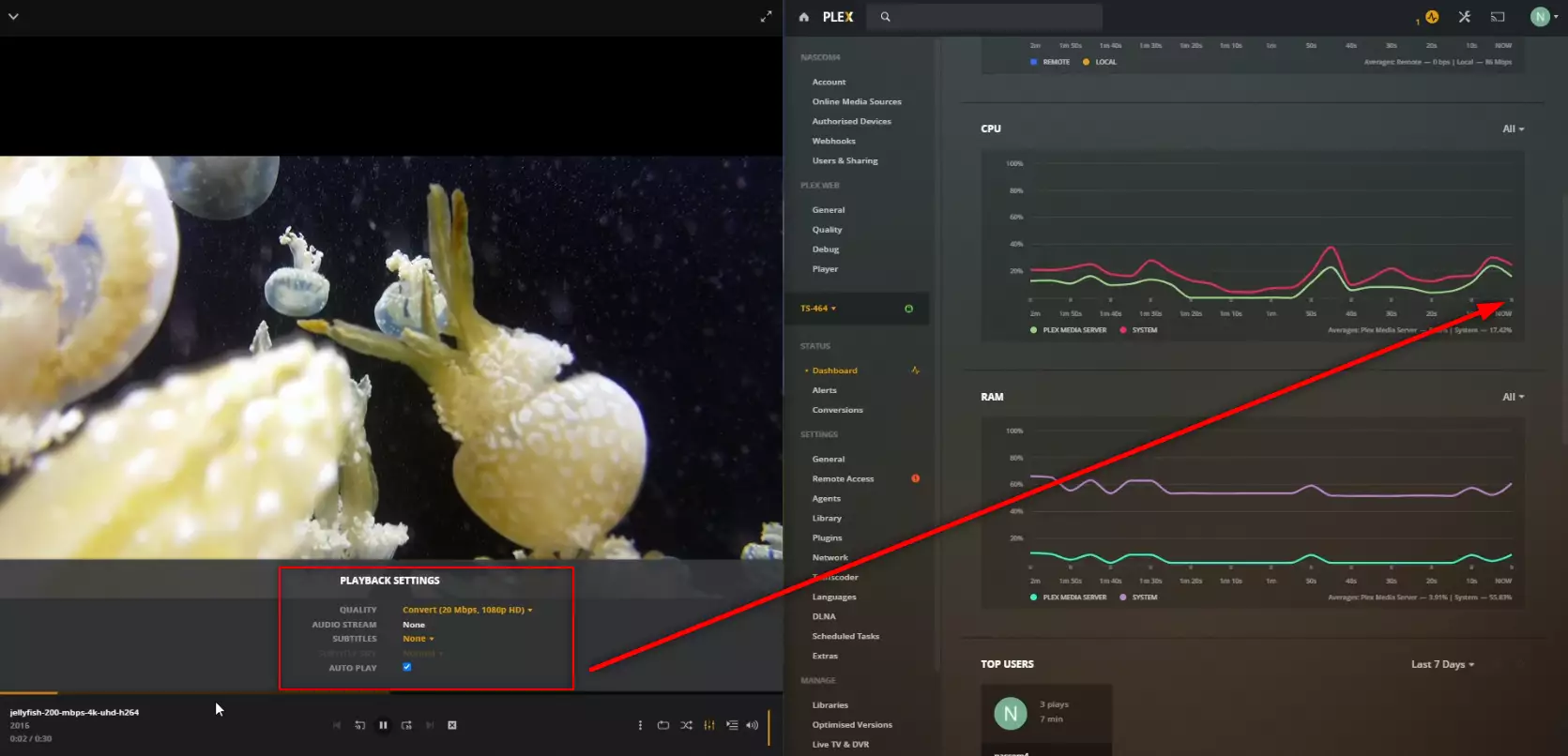
RESULT: PLAYED BUT HIGH CPU %
Extra Notes: Very Surprised this file was playable – it needed converting on the fly (HEVC etc), but despite the high CPU usage, it did a very good job
Plex Test 16 – QNAP TS-464 Plex NAS – Jellyfish 4K 400Mbps H.265 10bit – HEVC CONVERTED TO H.264 1.5Mbps 480p
Here is how the QNAP TS-464 Plex NAS – Jellyfish 4K 400Mbps H.265 10bit – HEVC CONVERTED TO H.264 1.5Mbps 480p File Performed:
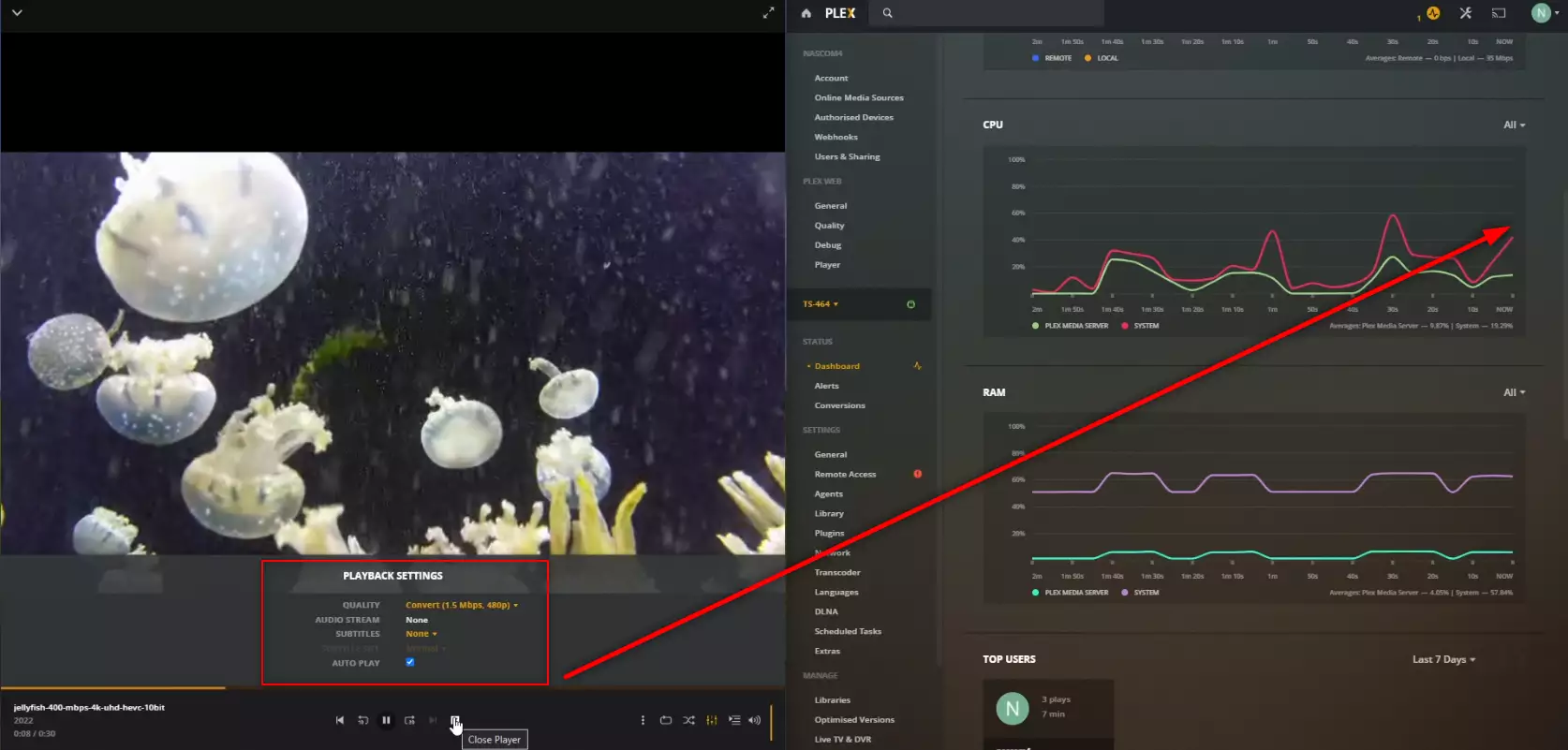
RESULT: FAIL AND-OR DID NOT PLAY
Extra Notes: VERY few NAS dries under £2500 will play this file as it is extraordinarily dense. I did NOT expect this Intel Celeron NAS to play this file.
Is the QNAP TS-464 NAS Any Good outside of Plex and Where Can I buy It?
If you are interested in learning more about the QNAP TS-464 NAS Drive, I am pleased to confirm that the review here on NASCompares is already live and you can find out more about this device below.
Quick Verdict of the QNAP TS-464 NAS – What We Said in the TS-464 Review:
The TS-464 comfortably arrives with the best hardware in its tier of the NAS market and that is something that QNAP has always been quite good at. Even if you rewind just 5 years, the level of hardware scalability and ease of upgradability that the TS-464 provides is frankly incredible and, fast forward to 2022, is still pretty unmatched. A Desktop 4-Bay NAS (eg Prosumer RAID 5 storage) has always been the next confident step for users who are tired of their hands being tied by subscription cloud services from Google, OneDrive and DropBox, who are looking for their own competent, flexible and fully-featured private server. In the TS-464 NAS, you find a system that is unquestionable the best hardware for your money you can possibly get right now. In software, things are a little less straightforward. QTS 5, although massively software and service-rich, arrives as a complete operating system in your web browser with multiple mobile/desktop clients and hundreds of applications and apps that can be installed at the touch of a button – which can all too often be something of a steep learning curve for many. Lacking the chewable, user-friendly nature of many of their rivals, QNAP and its software/service still have a tendency to be a bit of an information overload that can quickly intimidate the novice. However, for those that are looking for a system that is completely customizable in how/when/where you want data presented to you, as well as a wide degree of 3rd party support, QNAP and QTS 5 still manages to provide a huge degree of brand-unique service that are simply not available elsewhere. Just be prepared to invest your time wisely in its setup and more time ensuring the system is perfect for your needs.
Read the Rest of the Review HERE. Alternatively, you can find out the Pros and Cons below, as a few retailers that sell the QNAP TS-464 NAS. Thanks for reading and if you need any further help choosing the right NAS for your Plex Media Server, use the free advice section linked below. Have a great week.
Where to Buy a Product





![]()
![]()

VISIT RETAILER ➤






![]()
![]()

VISIT RETAILER ➤






![]()
![]()

VISIT RETAILER ➤






![]()
![]()

VISIT RETAILER ➤
📧 SUBSCRIBE TO OUR NEWSLETTER 🔔
🔒 Join Inner Circle
Get an alert every time something gets added to this specific article!
This description contains links to Amazon. These links will take you to some of the products mentioned in today's content. As an Amazon Associate, I earn from qualifying purchases. Visit the NASCompares Deal Finder to find the best place to buy this device in your region, based on Service, Support and Reputation - Just Search for your NAS Drive in the Box Below
Need Advice on Data Storage from an Expert?
Finally, for free advice about your setup, just leave a message in the comments below here at NASCompares.com and we will get back to you. Need Help?
Where possible (and where appropriate) please provide as much information about your requirements, as then I can arrange the best answer and solution to your needs. Do not worry about your e-mail address being required, it will NOT be used in a mailing list and will NOT be used in any way other than to respond to your enquiry.
Need Help?
Where possible (and where appropriate) please provide as much information about your requirements, as then I can arrange the best answer and solution to your needs. Do not worry about your e-mail address being required, it will NOT be used in a mailing list and will NOT be used in any way other than to respond to your enquiry.

|
 |
How Much RAM Do You Need in Your NAS?
A Buyer's Guide to Travel Routers - GET IT RIGHT, FIRST TIME
Jonsbo N6 DIY NAS Case Review
The Best Bits (and Worst Bits) of NAS of 2025!
Minisforum MS-02 Ultra Review
Minisforum N5 NAS, 6 Months Later - Better, Worse, the Same?
Access content via Patreon or KO-FI
Discover more from NAS Compares
Subscribe to get the latest posts sent to your email.


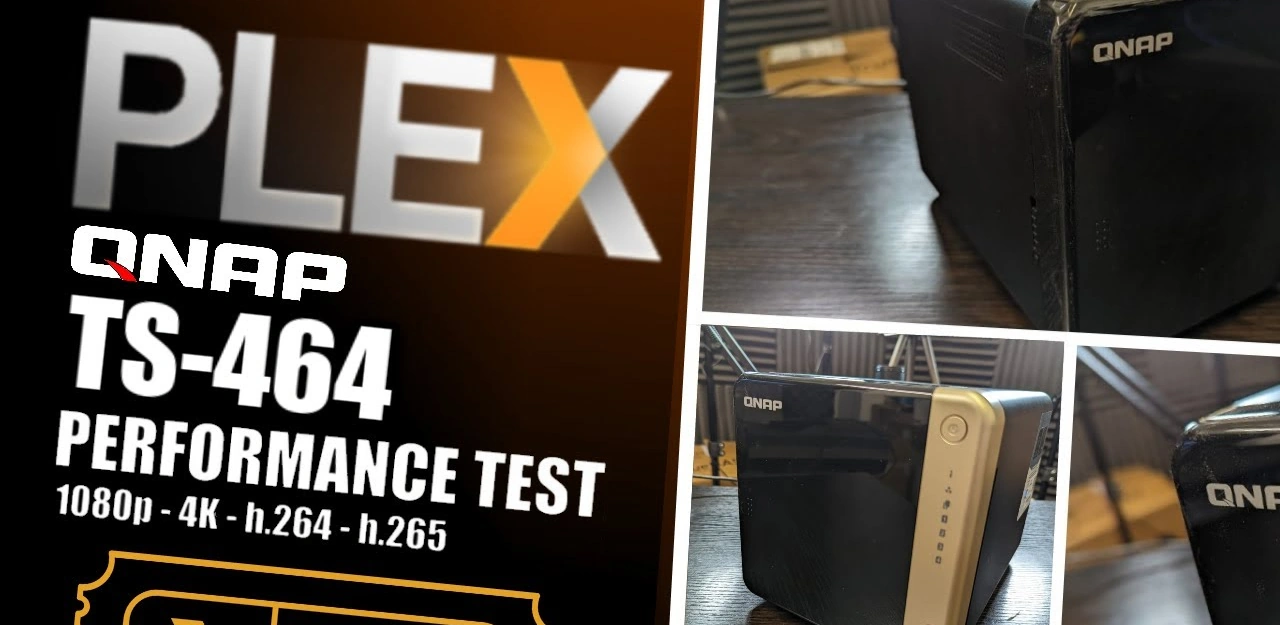
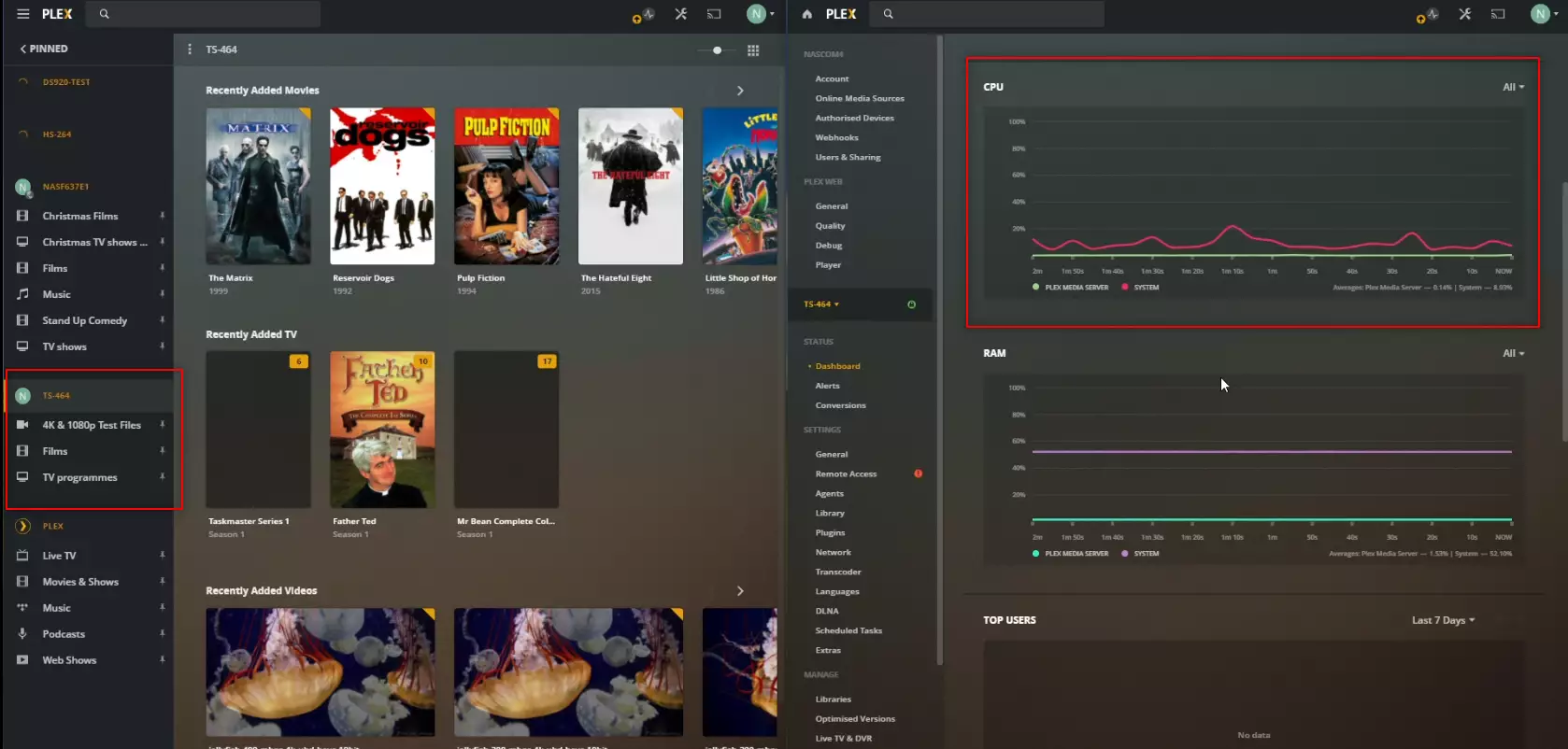



Is the RAM Soldered? I’d like to expand to 32GB.
REPLY ON YOUTUBE
is there a download link for all the differnt jellyfish video files?
REPLY ON YOUTUBE
Weird test, 4K movies max out at about 100Mbps.
REPLY ON YOUTUBE
Is the 4k performance only sluggish when using the QNAP for its internal transcoding…. Does it perform bad or sluggish of simply using to read off and using a Nvidia Shield Pro as plex and media playing?
REPLY ON YOUTUBE
zzzzzzzzzzzzzzz
REPLY ON YOUTUBE
try playing the files in vlc over the local network, I bet it would work better. My 15 year old nas plays 80-100mbit files through Kodi, so this seems rather strange (at original quality)
REPLY ON YOUTUBE
How are you getting this? I get ‘This server is not powerful enough to convert video’ even at 1080p.I have hardware transcoding turned on.
REPLY ON YOUTUBE
did I understand correctly that it is impossible to watch a downloaded torrent movie 4k hevc with a bitrate of 80mb / s on it
REPLY ON YOUTUBE
Most of my hevc / h265 movies are 20-30mb with some exceptions at 50-70mb, and others at 5-10mb.
Would of liked to see more realistic files played
REPLY ON YOUTUBE
I doesn’t seem like you made it clear in the video, but when you are playing the 10-bit HDR video files; is it performing tone mapping to SDR with hardware acceleration?
REPLY ON YOUTUBE
The bitrate for these “Jellyfish” 4K clips are extremely high so it’s not surprising they can’t be played. Compared to YouTube videos those bitrates are more comparable to 8K videos.
Can you please test again with 4K videos with a more “normal” bitrate, say 40-50 Mbps? That would be a much more realistic test. Preferably both h.264 and h.265/hevc. For example, Netflix 4K bitrate is often around 15-20 Mbps.
Also, you changed the transcoding quality to max (“make the cpu hurt”) which is optional. With a slightly lower quality it should work better with 4K video.
REPLY ON YOUTUBE
As nice as a standard test like the jellyfish files is, I’d love to see something more realistic. I’m sure there are people who really wanna play their raw 4K bluray rips with 200mbps but it’s not really realistic for the average Plex user in my opinion. Correct me if I’m wrong, but most people convert their files anyway using something like handbreak.
Maybe 5 minutes of 4K 80mbps H264/H265? That’s long enough to fill the transcoding buffer which is usually 60 seconds.
Most of my files are between 25-75mbps depending on the type, codec and audio tracks. As much as I’d like to just throw a 200GB “lossless” file into my library, I’d have to rent a server with hundrets of TB if I wanted to store all my movies that way.
To give some perspective, I have a 4K HDR version of The Dark Knight with DTS-HD MA Audio which is one of my biggest files with 70mbps H265. If I convert it to H264 without changing the quality the file would be maybe 100mbps.
REPLY ON YOUTUBE
I am looking to upgrade from my Synology DS-918+ and I’m thinking about switching to QNAP. I downloaded the jellyfish files and was able to direct play 4k h.265 all the way up to the 200 mbps file (without transcoding) from my DS-918+ to my Roku Ultra. So why is this being forced to transcode instead of direct play the h.265? Is it a QNAP limitation or is it a web browser limitation or a plex limitation?
REPLY ON YOUTUBE
@nascompares The big question for me: how does it perform with 4K/HEVC/10bit natively via HDMI?
REPLY ON YOUTUBE
This NAS does not show even in the mg page, not even in amazon
REPLY ON YOUTUBE
Great video. Just a quick question would the Qnap ts-364 preform about the same as it has the same chip as this one.
REPLY ON YOUTUBE
Why are you thinking it is transcoding at play ‘original’?
REPLY ON YOUTUBE
Does this Qnap support beignet/OpenCL? This is required to transcode 4K HDR content and avoid choking the CPU. My Synology DS718+ doesn’t support it natively so I had to run it in docker as it supported beignet/OpenCL, transcoding 4K Blurays doesnt choke anymore
REPLY ON YOUTUBE
Hey man, would you be interested to have a commissioned logo redesign for your channel to have a memorable monogram symbolic NAS logo? I’m a freelance logo designer and would love to craft a good logo for you! Let me know if you interested for my portfolio, concept and reasonable rate!
REPLY ON YOUTUBE
You should mention that you are using 10TB Ultrastar® DC HC300 hard drives.
REPLY ON YOUTUBE
Don’t forget to install your Windows updates. ????
REPLY ON YOUTUBE